Project 629 (NATO “GOLF”) conventional ballistic missile submarines
 23 submarines, Projects 629, 629B, 629A, 601, 605, 619, 629R, 6631/031 (1956-1990)
23 submarines, Projects 629, 629B, 629A, 601, 605, 619, 629R, 6631/031 (1956-1990)
Soviet Cold War Subs
Pr.613 Whiskey | Pr.611 Zulu | Pr.615 Quebec | Pr.633 Romeo | Pr.651 Juliet | Pr.641 Foxtrot | Pr.641 buki Tango | Pr.877 KiloPr.627 kit November | Pr.659 Echo I | Pr.675 Echo II | Pr.671 Victor I | Pr.671RT Victor II | Pr.671RTMK Victor III | Pr.670/670M skat Charlie | Pr.705 lira Alfa | Pr.949 antey Oscar | Pr.945 Sierra | Pr.971 bars Akula | Pr.885 graney Yasen | Pr. 545 Laika
Pr.629 Golf | Pr.658 Hotel | Pr.667A Yankee | Pr.667B Murena Delta I | Pr.667D Delta II | Pr.667BDR Kalmar Delta III | Pr.667 BDMR delfin Delta IV | Pr. 941 akula Typhoon | Pr.995 borei Dolgorukiy | Pr.09851 Khabarovsk
The first soviet strategic submarines
The Golf class submarines (Project 629) were the first Soviet SSBs and world’s only Conventional class of ballistic armed strategic submarines (The Zulu V were experimental), commissioned one year before the Georges Washington class. They were not indeed of a design that could be recognized as “classic”, and were closely related to the Zulu V class, ballistic launching conversions of conventional submarines. Their launched only three ballistic missiles located in the sail, not in the hull. In short, despite being late by a year, the USN still got a comfortable advance in sea deterrence over the Soviet Union, in quality versus numbers. The follow-up Gold class were improvised SSBNs with the same nuclear reactors as in the November class SSNs, and were plagued by issues. The USSR only properly answered by the “Yankee” class from 1966 onwards as Project 667A Navaga and Project 667AU Nalim. The class was split between improved variants recognised by NATO as Hotel I, II and III, all discarded in 1990.
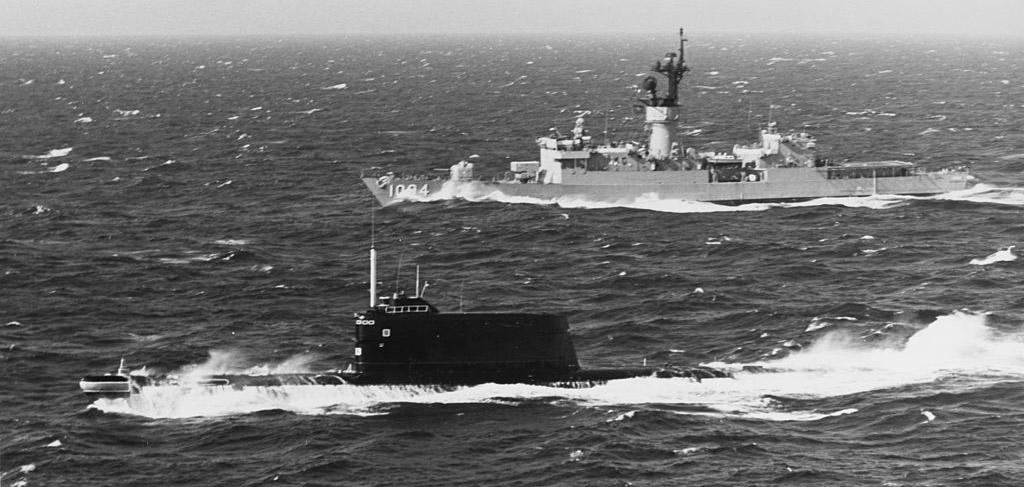
USS Pharis (FF-1094) underway off Copenhagen February 1978 shadowing a Golf II submarine
Development of Project 629
Initial developments 1946-55
In the leading up to the first ballistic submarines, both the USA and USSR experimented with nuclear-tipped cruise missiles, which easier to build. The impetus were the first V-1 missiles obtained from Germany, as well as blueprints and engineers as part of Operation Paperclip.
Soon the Army competed with the Navy to test its first ship-launched, and then submarine-launched V1s in the hope to fit a nuclear warhead on this. This was part of the postwar Navy/Air force dispute about the monopoly on the nuclear deterrence. The Air Force had the lead in this and maintained it for years (The navy lost, after the cancellation of the United States class). But nothing could prevent the Navy to opt-in for a rapid conversion of a Gato-class boat for such tests.
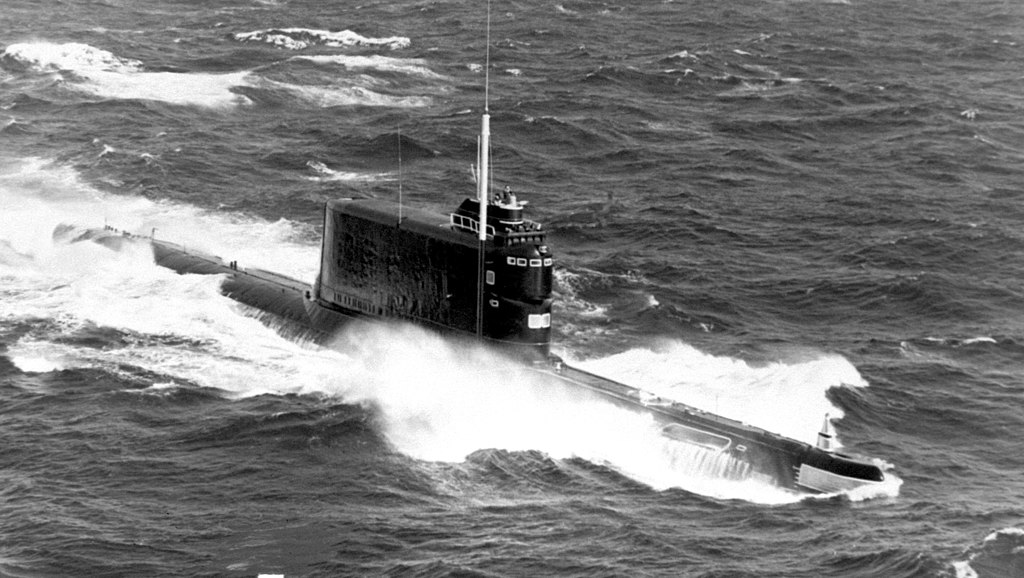
The Soviet Navy was looking at promising development in nuclear power, but also in both cruise and balltistic missiles. In that area, for example, the Burya was a supersonic, intercontinental cruise missile developed by Lavochkin as La-350 (Ла-350) from 1954. At 19m long it was far too large for ship operations. More realistically the SS-N-3 or P-5 “Pyatyorka” (NATO Shaddock) was a more realistic proposition, but paradoxically to what happened to the USN, cruise missile launcher submarines arrived after the ballstic ones, with the conventional Juliett and nuclear Echo. The P-5 indeed had a protracted development and only entered service in 1959. It suceeded to the mediocre KSShch alias SS-N-1 Scrubber (Kildin/Kanin). The P-5 was completed from 1960 by the P-15 Termit
(SS-N-2 Styx).
As for ballistic missile goes, Soviet scientist had a wealth of secret German documents from Peenemünde, even quite a few (2500) German scientists forcibly took into Soviet Union, namely under Operation Osoaviakhim, as well as engineers and technicians working in R&D as well as companies and institutions in the Soviet occupation zone of Germany and Berlin.
It was not done in 1945 unlike for the allies, but in early morning hours of October 22, 1946 by MVD, simultaneously across the Soviet-controlled zone. The most crucial part was the literal transplant of research and production research centers on the V-2 rocket center in Mittelwerk and collect all available material from test centers, notably at the Luftwaffe’s central military aviation test center (Erprobungstelle Rechlin) from 2 May 1945 onwards.
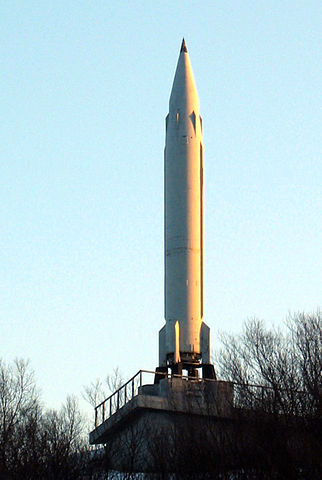 Thinks to this wealth of information, the first task of engineers was to try to replicate the V2 by all means. As the world’s first ballistic missile, it formed the basis for further developments that would culminate aside, for propaganda purposes, to the space race with the US. At the end of 1947, German scientists made a replica German V2, successfully launched in USSR, by November 1948, a Soviet one developed by Sergei Korolev (R1, the “R” standing for “Raketa” -rocket-) as an improved V2. The latter was produced and fielded to army units from May 10, 1951. Sergei Korolev became soon the most prominent Rocket designer and was a technical adviser with the rank of colonel, seconded to the Zentralwerke in Bleicherode.
Thinks to this wealth of information, the first task of engineers was to try to replicate the V2 by all means. As the world’s first ballistic missile, it formed the basis for further developments that would culminate aside, for propaganda purposes, to the space race with the US. At the end of 1947, German scientists made a replica German V2, successfully launched in USSR, by November 1948, a Soviet one developed by Sergei Korolev (R1, the “R” standing for “Raketa” -rocket-) as an improved V2. The latter was produced and fielded to army units from May 10, 1951. Sergei Korolev became soon the most prominent Rocket designer and was a technical adviser with the rank of colonel, seconded to the Zentralwerke in Bleicherode.
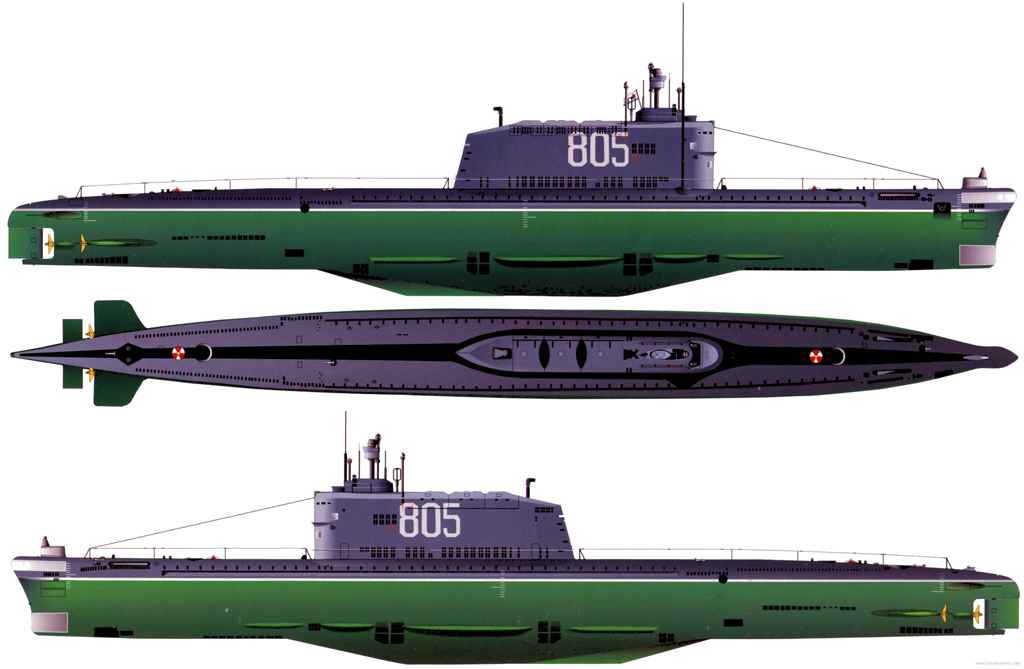
Project 629K Golf-I (unknown Russian publication, via pinterest)
After R-1 came R-2 from 27 November 1951, barely improved, but if ideas in the Navy to adapt those in tubes for ships or submarines was present, there were still unsurmountable problems. The R-5 Pobeda became the truly first Soviet intercontinental missile, but it was far too large for ship or submarine use. Thus was developed the R-13 as truly first submarine-launched ballistic missile (SLBM) developed around 1955 (NATO SS-N-4 Sark/GRAU index 4K50), or Navy designation D-1. It became the main payload of the Project 629 and Project 658 submarines (see below).
Detailed developments
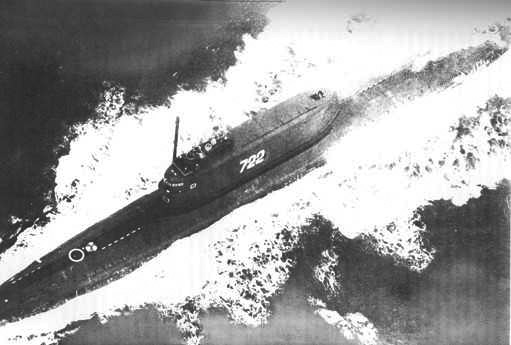
K-129 underway, photo by USN aircraft
The technical assignment (TTZ) for the development of a diesel-electric submarine armed with ballistic missiles arrived at TsKB-16 in May 1954. In order to achieve standardization, it was planned to take the proven project 641 (NATO) as basis for the new boat. Already at preliminary design stage, designers showed that the requirements could not be realistically met, so TTZ was revised, re-approved in January 1956, leading to the creation of the D-2 missile in parallel with the construction of the dedicated submarines. N. Isanin’s proposed to build boats withthe D-1 with a structural reserve for future re-equipment with D-2. This was accepted. Lead ships, B-92 and B-93, were laid down in Severodvinsk and Komsomolsk-on-Amur in 1957. By late 1958 they entered testing phase. Construction of the serie went on until 1962. 16 were built for the Northern fleet, 8 for the Far East fleet, and K208 for the Chinese Navy.
The preliminary design, carried out under the guidance of chief designer of the boat N.N. Isanin revealed a “complete inconsistency of requirements for TTZ 1954” quite evident for the missiles as Soviet tech was not able to provide the submersible launched intercontinental models asked for. On January 11, 1956, new TTZ for the D-2 was approved containing radical revised requirements. To speed up commissioning of the first Project 629 boats, Isanin proposed tubes fir for the D-1 in final tests, with provisions for the D-2 later.
Design of the class
Project 629 submarines due to this choice were focd to launch their missiles surfaced, and to correctly vent the exhaust burst, and other design reasons, it was decided to locate them in the sail. To lower the center of gravity and ensure positive stability during ascent the rocket compartment was designed in a “eight”, with two cylinders intersecting on a spacer platform. There was also a retractable device to erect the missile up to the top of the sail before launch.
Hull and general design
The hull generally resembled that of the Foxtrot class (Project 641), taken as the new standard of the Soviet attack submarine force, to replace gradually the new obsolete Project 611 (NATO Whiskey). So most of it will be seen when looking at Project 641. Changes mostly concerned the added section amidship, new fin and tubes.
The final Project 629 boats were much heavier than a 641, displacing 2,794 tons surfaced and 3,553 tons submerged and after upgrades on the 629A, 2,300–2,820 tons surfaced and 2,700–3,553 tons submerged (629A). The hull measured 98.4 m (323 ft) overall initally, 98.9 m on the 629A. Beam wa sunchanged at 8.2 m (27 ft) and draught was 7.85 m (25.8 ft) for the basic design and 8.5 m for Project 629A.
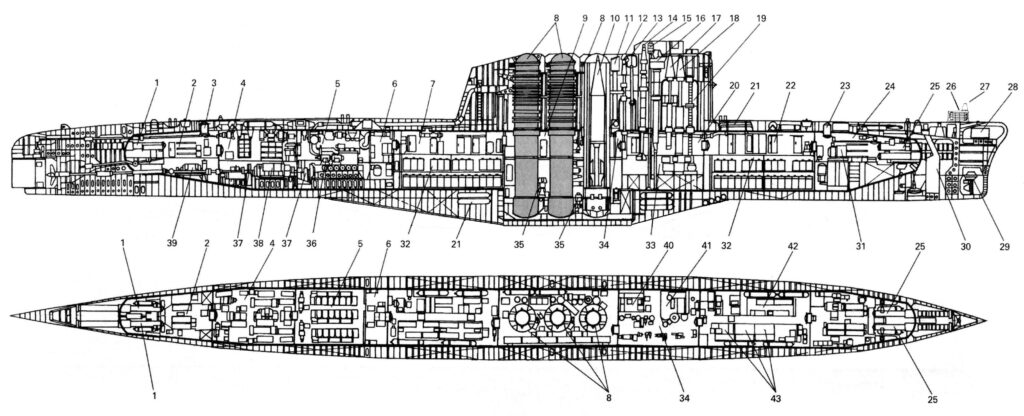
Project diagram, Porject 629 with D-1 missiles:
The submarine was divided in eight compartments:
1 – Feed system rear tubes;
2 – aft torpedo/living compartment;
3 – aft entrance hatch;
4 – electric motor compartment;
5 – diesel compartment;
6 – fencing for remote control of diesel engines;
7 – aft battery/living compartment;
8 – missile silo;
9 – missile (fourth) compartment;
10 – R-13 rocket;
11 – PMU astrocorrector (installed in repair/modernization);
12 – PMU AP radar “Flag”;
13 – PMU radio direction finder PR-1;
14 – PMU VAN; 15 – PMU AP stations “Nakat” and “Khrom-K”;
16 – retractable RDP shaft with a float valve;
17 – PZN-9 periscope;
18 – periscope “Lira-1”;
19 – durable cabin;
20 – third (central post) compartment;
21 – cylinders of the VVD system;
22 – bow battery (living) compartment;
23 – bow entrance hatch;
24 – bow torpedo (living) compartment; 25 – nasal TA;
26 – antenna radome of the GAS “Sviyaga”;
27 – radome of the GAS “Svet” antenna;
28 – GASMG-10 antenna;
29 – antenna of the GAS “Arktika-M”;
30 – chain box;
31 – electric compressor of the VVD system;
32 – AB; 33 – gyropost;
34 – central post;
35 – mechanisms for turning and lifting the starting tables;
36 – diesel 37-D;
37 – tire-pneumatic clutch;
38 – center line of the PG-101 shaft;
39 – GED for economic cruise PG-104;
40 – chart room;
41 – radar room;
42 – wardroom;
43 – officers’ cabins.

Diagram of the Project 629A, no legend.
Power plant
Again, same as project 641 (Foxtrot): Three diesel engines, on for each propeller shaft, one centerline, for cruise, two outer ones for speed and agility). Each delivered 2,000 bhp (1,500 kW) for a combined 6,000 bhp, completed by three electric motors delivering 5,200 shp (3,880 kW) each for 15,600 bhp, and a surface speed of 17 knots, 12 submerged. Range was 9.500 nmi at 5 knots. They had a 70 days endurance. Test depth was 260 m as designed, and down to 300 m maximum calculated before crush.
To compare, Project 641 boats had three 37D diesel engines 2000 bhp each. one auxiliary motor PG102rated for 2700 hp, two PG101 motors of 1,350 hp each, and Economical electric motor PG104, rated for 140 hp. And 4 groups of 112 elements type 46SU for the battery.
Armament
The missiles were housed in silos, fueled for three months (a full overseas deployment). After this, fuel was unloaded to check the technical condition of the inner tanks. Firing was performed eventually from a depth of up to 50 m in sea waves up to 5 points while at 4 knots. 5 minutes befire launches were necessary to clear up exhaust fumes. Each sub carried for guidance the Stavropol-1” and “Izumrud-1” systems, pointing angles of the rocket’s on-board gyro relative to the firing plane and horizon plane. The Sigma navigation the calculated a course, determined the submarine speed and current value of geographic coordinates, taking account of roll and pitch angles.
D-1 Missiles (R-11FM)
Initial missile used on the first three Project 629 boats. Originally the R-11 Zemlya, it was navalized as R-11FM, first tested at Kapustin Yar in February 1955 and first launched from a converted Project 611 (Zulu) by September. Development under Korolev’s OKB-1 was transferred to Makeyev’s SKB-385 in August 1955. It entered service in 1959 as the D-1 launch system. Incidentally this was the the world’s first submarine-launched ballistic missile, first operationally used on the Project 611 and Project 629 submarines, and then replaced by the R-13 in 1961 (SS-N-4) and in 1963, the R-21 (SS-N-5). 77 launches were made, 59 successful. It was basically an improved variant of the well-known and infamous SCUD family.
D-2 Missiles (R-13)
 Development of the R-13 was authorised by the Soviet Supreme Council on 25 July 1955 for Project 629 and Project 658 submarines. Design started at OKB-1 under Sergei Korolev and transferred to CB Miasskoe engineering or Makeyev Rocket Design Bureau under Viktor Makeyev. Final TTZ was approved on 11 January 1956. Production started at Zlatoust Machine-Building Plant in 1959. It entered service in 1961. it was similar to the R-11FM missile but phased out from 1965 to 1975.
Development of the R-13 was authorised by the Soviet Supreme Council on 25 July 1955 for Project 629 and Project 658 submarines. Design started at OKB-1 under Sergei Korolev and transferred to CB Miasskoe engineering or Makeyev Rocket Design Bureau under Viktor Makeyev. Final TTZ was approved on 11 January 1956. Production started at Zlatoust Machine-Building Plant in 1959. It entered service in 1961. it was similar to the R-11FM missile but phased out from 1965 to 1975.
It used vernier thrusters for course and trajectory alterations instead of control surfaces yet still four stabilizers. Initiall, 26 of 32 missiles (81%) were successfully launched. During service, 225 of 311 launches (72%) were successful.
Dimensions: 11.8 m (38 ft 9 in) x 1.3 m (4 ft 3 in) wingspan 1.9 m (6 ft 3 in)
Liquid-fuel rocket prop. single stage, AK-271 Oxidizer, TG-02 fuel, Range 600 km (370 mi)
Launch weight: 13.7 t. Single thermonuclear: 1.2 to 2.0 Mt (perhaps as low as 1.0 Mt)
Accuracy 1.8 to 4 km (1.1 to 2.5 miles).
Torpedo Tubes
Same as the Foxtrot class, they all had the same fixed armament, but in that case reduced to six 533mm (21-in) torpedo tubes, 4 at the bow, two at the stern. To compare, the Foxtrot had ten torpedo tubes, 6 at the bow, 4 at the stern for 22 torpedoes total. This wa sprobably reduced down to 12 on the Golf.
As for the torpedoes themselves, they were likely the 533 mm (21″) SET-53 and SET-53M, ASW passive acoustic homing torpedo. The homing system scanned up to 660 yards (600 m).
The SET-53M had a range of 15,300 yards (14,000 m) at 29 knots.
Sensors
All Project 629 boats had the “Flag” radar, MG-200 Arktika-M, Tuloma and Svet sonars as well as the Nakat ECM suite
K815 and 816 differed in having the MG-10 Kola.
Later with Project 629A this were the RLK-101 Albatros radar, MG-200 Arktika-M, MG-10 Kola and Svet-M sonars as well as the Nakat-M ECM ECM suite.
Variants & modernizations
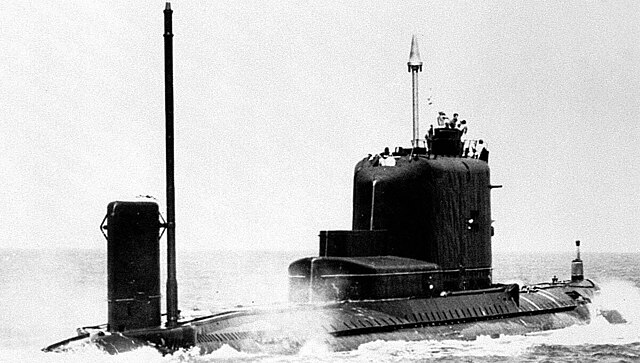
Pr.629R BS-107 boat, stern view. These were picket and communication subs (NATO SSQ) equivalent to the US migraine class. They could be used for communication relay, spying off shore, or mid-flight missile guidance as well.
In 1966, K-88; 1967, K-91, K-129, K-99, K-142 and by 1968-69, K-96, K-79, K-126 were modernized as Project 629A, as well as in 1970-72 K-139, K-93, K-75, K-72 and K-163 to fire the R-21 SLBM (3 4K55) and upgraded with the RLK-101 Albatros radar, MG-200 Arktika-M, MG-10 Kola and Svet-M sonars as well as the Nakat-M ECM ECM suite.
In 1967 K-36 under Project 629A was modernized like the above, but with the MG-17 and MG-23 in addition to MG-10 Kola systems.
In 1975 K-102 was converted under Project 605 (see below) to fire four R-27K SLBM (4K18) sensors as above but the MG-23 and MG-10M Kola sonars plus upgraded Nakat-KM ECM suite.
In 1976, K-118 was converted under Project 601 to fire six R-29 SLBM (6 4K75). Sensors, as above but Alfa-2 CCS suite. See below.
In 1976 B-167 and 1977 B-107, in 1979 BS-83 were all converted under Project 629R command and communication submarines (SSQ) with three R-13 SLBM and only stern 533mm tubes. The space was used for a very large communication equipment.
In 1978, BS-153 was modified under Project 619 (see below).
Project 629B

Project 629B Golf I
The sixteenth ship of the series, K-142, was built according to a modified design and was intended to test the D-6 solid-fuel missile system and the D-4 liquid-fuel missile system with the R-21 missile. After 27 launches of the R-21 missile, she entered service as part of the D-4 range of SSGs.
Project 629A

Project 629A Golf I
In July 1962, it was decided to modernize Project 629 boats according to Project 629A, stating the uograde to the D-4 complex system (R-21 missiles) after the test boat Pr.629B. The project was developed with the condition of minimizing the amount of modernization work. The main changes have undergone the 4th compartment and its inter-hull space. New missile silos and additional ballast tanks were installed to prevent the boat from floating after firinng as well as a new trim management system.
Project 629R (NATO Golf SSQ)

In 1971-1972, on the basis of a type 629 boat, a project was developed for the 629R relay submarine, designed to provide stable communications between the fleet command and surface and underwater ships located anywhere in the World Ocean. The project included the dismantling of the missile system, aft torpedo tubes and the Pluton-629 navigation complex to accommodate antennas, radio equipment and the Most-U navigation complex. Stable simultaneous operation of reception and transmission was ensured by separation of the receiving and transmitting antennas and additional protection of the receivers from interference. It was planned to re-equip four Project 629 boats: K-83, K-107, K-61 and K-113. Subsequently, the K-113 modification was abandoned. The re-equipped ships received the names BS-83, BS-107, BS-61. All three ships entered service by 1978.
So in short, K-61, B-42 and K-107 were converted in Vladivostok into command post submarines, between 1973 and 1979, missile and torpedo tubes removed and NATO gave them the identifier “Golf SSQ”.
The 629R were still relatively similar, at 2,820/3,090t and 98.9m x 8.20m x 8.00m (speed 15.5/12.5kts, crew 59) and armament reduced to a single R-39 SLBM (3M65) but still six TTs.
Project 601 (Golf III)

K-118 boat, Project 629, was modernized to test the D-9 missile system with six RSM-40 (R-29) missiles. The project required significant redesign and about 70% of the external hull and more than half of the pressure hull compartments were replaced. Tests started in 1976. After tests, the ‘D-9 complex’ entered service. This unique submarine constituted the basis for the Project 667B Murena (Delta I) nuclear submarines. It is planned that a modification of this complex called D-9RMU2 would be in service at least until 2020. NATO Golf III.
Specs: Displacement 4,160 surfaced, 5,180t submerged, 117.6 x 8.20 x 8.10m, top speed 13.8 knots surfaced, 13.5kts under water, range 7,300 nm surfaced at 8 kts or 95 nm at 2.3 kts, crew 98. She was armed with six R-29 SLBM (4K75) and same torpedoes or radar/sonar suite, but the Alfa-2 CCS.
Project 605 (Golf IV)

K-102 was chosen to fire the D-5 missile system, testing both the R-27 and R-27K (4K-18, and NATO SS-N-13) missiles. These were designed to hit point targets on shore as well as aircraft carriers (respectively). So from strategic, the Golf became a tactical submarine. Initially, it was planned to install six missiles, but due to restrictions in sets of control equipments, this was later limited to four missiles and she was “only” lengthened by 18.3 m (60 ft). This conversion was developed in 1968-1969, with a re-equipment completed by September 1973. The missile was tested from September 11, 1973 to August 15, 1975. Other Project 629 ships were not converted, and K-102 remained unique. The D-5 missile system formed a working base for Project 667A Navaga submarines (NATO Yankee class). Specs: Hull was lengthened to 116 x 8.20 x 8.10m and disp. 3,642 surf/4,540t sub. top speed 13.7/11.7kts, 8,150nm at 8 kts or 1322 nm at 3 submerged. crew 99. So K-102 received the NATO reporting name “Golf IV”
Project 619 (Golf IV)

The K-153 boat was converted to test the D-19 missile system and received the name BS-153. The conversion was carried out at Sevmash, the boat was equipped with one silo for launching a ninety-ton three-stage rocket of the RSM-52 (R-39) type. Tests took place on the Black Sea in 1979, seven launches of dummy models were carried out. Subsequently, the D-19 complex was installed on the largest Project 941 Akula TRPKSN (NATO Typhoon class). In the future, it was planned to use the D-19UTTKh (R-39UTTKh “Bark”) missile system for testing, but this was cancelled.
Type 6631 (Yuanzheng 1101/200)

A Chinese-built Golf-class submarine built in Dalian between 1960 and 1966 after planning and development in 1959, with a Chinese delegation. China indeed at the time was developing its own nuclear program with Soviet help and planned a Chinese-built SLBMs, thus, the Type 6631 built at Dalian with assistance of Soviet engineers was equipped with simulation systems, mainly used for training.
In accordance with the decree of the USSR Government dated 01/09/1959, TsKB-16 from March to December 1959 prepared working drawings and technical documentation for the project629with the D-1 complex with R-11FM missiles for their transfer in China.
By the fall of 1960, at Shipyard No. 199 in Komsomolsk-on-Amur, a submarine for the Chinese Navy (serial 138) was laid down with elements coming from B-113 (project 629) at yard No. 199. By 1962, the submarine was transported in parts to Dalian, laying the first of Chinese submarines under project 031G.
She received the pennant Yuanzheng “1101”, changed to Yuanzheng “200” in 1967.
By 1964, she entered service with the pennant 200 and the PRC after the split used parts from the dismantled Soviet submarine B-46, Project 629, but was unable to assemble another sister ship. The second boat of the class was indeed supposed to be built and delivered by USSR and fully functional (pennant “K-208” in some sources), but due to the Sino-Soviet split, the on-board equipment was not delivered and instead, Chinese engineers became hard at work to reverse engineering the first one, entering Chinese service in August 1966. In June 1968, the Type 6631 went through a major refit when it was decided to swap to solid-fueled SLBMs instead of liquid-fueled ones (Soviet style). Simulation equipment was replaced by support equipment dedicated to solid-fueled SLBMs as well and the SLBM silos were overhauled as the missiles had different dimensions, with only two silos carried instead of three.
In 1974 indeed, Pr.031 #200 underwent modernization with one missile silo removed to make room for two new ones housing the experimental JL-1 ballistic missile, making a first launch on 10.10.1982. In 1983, information leaked about a launch accident in which many Chinese scientists died. In USSR some related it to a collision with K-10 (Project 675) as the latter reported such collision with an unidentified underwater object. However, the Chinese Navy denied it. By 2011, the boat was still used to test new missile systems and was the base for the Type 032 submarines.
Chinese Type 031G (Changcheng 200)

PLAN Type 031G
Same boat as above, the Type 6631 after her major refit completed in November 1978. Unlike the Golf class, she launch solid-fueled SLBMs under water. This first operational SSG in Chinese PLAN service was called Type 031, official name “Great Wall” (Changcheng) from the 1980s. Later it was fixed to “Great Wall 200” as all deterrence boats were named that way. This paved the way for the much more modern Type 092 or NATO Xia class SSBN.
⚙ specifications 629/629A* |
|
| Displacement | 2,794 tons surfaced/3,553 tons submerged |
| Displacement* | 2,300–2,820 tons surfaced/2,700–3,553 tons submerged |
| Dimensions | 98.4 x 8.2 x 7.85m (323 x 27 x 25.8 ft) |
| Dimensions* | 98.9 x 8.2 x 8.5 m (324 x 27 ft x 28 ft) |
| Propulsion | 3 shafts diesels 2,000 bhp (1,500 kW), 3× electric motors 5,200 shp (3,880 kW) |
| Speed | 17 knots surfaced 12 knots submerged |
| Range | 9.500 nmi at 5 knots, 70 days endurance |
| Armament | 3× missile tubes D-1 (R-11FM)/D-2 (R-13) or D-4 (R-21)*, 6× 533 mm TTs |
| Test Depth | 260 m (design), 300 m (maximum) |
| Sensors | |
| Crew | 80, 83* |
Construction, tests, prototyping
Construction of the two lead boats commenced in 1957 at Severodvinsk, Komsomolsk-on-Amur. At the end of 1958, first tests strted just as Project 629 mass production was approved. By the start of 1960, the Northern Fleet received five of these, he Pacific Fleet two but in 22 wwould be delivered. Before the adoption of the R-13 missiles/D-2 the first three boats commissione had instead the inferior R-11FM (D-1 complex).
Project 629 was the main production variant with the R-13 missile. From November 1959 to August 1960, the prototype performed 13 launches, 11 successful from B-92, Northern Fleet, and by October 13, 1961, the R-13 was accepted into service. K-102 (commander – G.I. Kaymak and missile commander V.N. Arkhipov, control group cdr V.F. Savenko on October 20, 1961 performed the world’s first launch of a ballistic missile R-13 with a one megaton yeld thermonuclear charge aboard. Like the R-11FM, the R-13 could only be launched from the surface, the launch time of the first missile after surfacing was 4 minutes, which significantly reduced their combat value, despite artist views showing the contrary. Only from the D-4 system onwards this became possible.
Successful tests of missiles and various systems led to design the improved D-4 (R-21), up to flight testing. To speed up development, it was decided to combine flight design and military trials, conducting joint tests. The Navy C-i-C allocated Project 629B K-142 (Northern Fleet) for tests. The first launch of the R-21 underwater was performed on February 24, 1962. 27 launches were carried out until the process became more reliable and safe. The D-4 was adopted for service by May 15, 1963. It was a significant step forward, but still single-stage, with load-bearing fuel tanks and detachable warhead. No comparison to the Polaris.
In 1959, preliminary design for Project 629D4 boats was completed after a long study of installation of a brand new launch facility, weight and size of the new missile and related elements. It followed the Project 629B and by July 1962, became a motive to modernize all Project 629 to adopt the D-4 missile system. Main changes affected the fourth compartment and the ‘8’ platform space inside. New shafts were installed as well as additional ballast tanks to keep the boats steady when launching.
In 1960-1962, three boats at Severodvinsk were modernized to the D-2 standard, K-96, K-72 and K-79. 14 were modernized in all including six at the Leninsky Komsomol Shipyard. Suddenly their combat value went up radically, with a submerged launch and range up to 1,400 km (to compare, the Polaris was capable of 2,500 nautical miles (4,600 km)).
These were the first Soviet ballistic submarines with underwater launch ballistic missiles. Six were stationed in the Baltic Fleet and the rest in the Pacific, where they had no bottleneck to start patrolling far and wide, apart te US-controlled Japanese archipelago and Alaskan chain. They remained in service until the end of the 1980s. During conversion some had the new “Zubatka” and “Paravan” navigation system tested.
K-118 saw her hull lengthened by 20 m in order to accommodate six silos for testing the type R-29 (4K-75) or D-9 complex, as part of project 601.
K-153 was modernized under Project 619 prototype to test R-39 missiles, D-19 complex , just one silo. A total of 9 missiles were launched from a floating stand, 7 from the submarine.
K-102 was converted as Project 605 testing the D-5K missile system, R-27 missile, then R-27K missile which was enchanced for trajectory adjustments at the final stage of the flight. This became the 4K-18 (SS-NX-13), designed to target US Carrier Battle Groups, with pinpoint accuracy. Tests started in 1974.
K-113 by the mid and late 1970s was also converted as project 629N, becomin a test stand carrier for diver towing vehicles (Proteus-X type) as well as towing cargo containers with the “Rinadon-2” system for Spec Ops. Tugs were located in the bow compartment on racks. Some sources stated it was later converted as minelayer project 629I or 629E.
Thee boats also had their missiles tubes dismantled, and antennas placed instead for additional long range communication/control capabilities. This was project 629R. They remained in service until the early 1990s, two converted for reconnaissance in the Pacific Fleet and Northern Fleet under a new project number.
There are also a number of cancelled variants like:
–629P, preliminary design for the D-4 missile system
–629D6 1959 preliminary design for the D-6 missile system, in 3 silos
–629D7 1962 preliminary design for the D-7 missile system
–B629 Ssubmarine project with a single R-15 missile
–629M Auxiliary nuclear installation test conversion
–629KS torpedo version only and 629KO command subs are sometimes noted in no russian sources but dubious.
Career of the Hotels
 K-96
K-96
B-92, К-96 in 7.1977 then B-96, pennant 801. Built at Northern Wks, Severodvinsk, laid down 14.10.1957, launched 16.9.1958, comp. 29.12.1959, stricken 9.1987
 K-72
K-72
B-40, from 1960 К-72 and from 1977 B-372, pennant 802, built at Northern Wks, Severodvinsk, laid down 16.12.1957, launched 12.4.1959, comp. 30.11.1959. Stricken 5.1989
 K-79
K-79
B-41, К-79, B-79, pennant 803, built at Northern Wks, Severodvinsk, laid down 17.2.1958, launched 16.6.1959, comp. 25.11.1959, stricken 5.1989
 K-83
K-83
B-42, К-83, B-83 pennant 804 was built at Northern Wks, in Severodvinsk, laid down 26.4.1958, launched 23.7.1959, comp. 29.11.1959, stricken 7.1988
 K-102
K-102
B-121/К-102/B-102, pennant 805, built at Northern Wks, laid down on 28.5.1958, launched 19.9.1959, completed 25.12.1959. She was stricken on 7.1980
 K-107
K-107
К-107/B-125/B-107, pennant 806, built at Northern Wks, laid down 12.11.1958 launched 23.4.1960, completed 17.8.1960. She was stricken 6.1991 Project 629
 K-88
K-88
К-88/B-45/B-183, pennant 807, built at Northern Wks, laid down 20.11.1958, launched 4.6.1960, completed 15.9.1960, stricken 10.1990
 K-61
K-61
К-61/B-29/B-167/BS-167, pennant 808, built at Northern Wks, laid down on 20.5.1959, launched 27.8.1960, completed 26.11.1960, stricken 4.1989
 K-113
K-113
К-113/B-146/B-113/BS-113, pennant 809, built at Northern Wks, laid down on 10.7.1959, launched 17.9.1960, completed 30.11.1960. She was demoted as a recharging station in April 1978
 K-118
K-118
К-118/B-149/B-118, pennant 810, Northern Wks, laid down on 22.10.1959, launched 29.9.1960, completed 10.12.1960. She became a recharging station by June 1986
 K-36
K-36
К-36/B-95/B-106, pennant 811, built at Northern Wks, laid down on 18.3.1960, launched 9.5.1961 and completed 31.8.1961, stricken 1.1989
 K-91
K-91
К-91/B-91, pennant 812, built at Northern Wks, laid down 9.8.1960, launched 27.5.1961 and completed on 23.9.1961. She was stricken 10.1986
 K-93
K-93
К-93/B-93, pennant 813, built at Northern Wks, laid down on 10.10.1960, launched 18.7.1961, completed 16.11.1961, stricken 3.1989
 K-110
K-110
К-110/B-110/BS-110, pennant 814, built at Northern Wks in Severodvinsk, laid down 1.12.1960, launched 25.8.1961 and completed on 28.11.1961, stricken 2.1979
 K-153
K-153
К-153/B-153/BS-153, pennant 815, built at Northern Wks, laid down 7.12.1960, lauched 27.9.1961 a,d completed o, 15.12.1961, stricken 9.1990
 K-123
K-123
B-93, К-126, B-126, pennant 131, built at Leninskiy Komsomol, launched 5.10.1957, launched 16.8.1958, completed 31.12.1959; stricken 6.1988
 K-129
K-129
B-103/К-129, pennant 132, built at Leninskiy Komsomol Yd, laid down 15.3.1958, launched 6.5.1959, completed on 31.12.1959. This 629A boat of the Pacific Fleet sank during a combat patrol on March 8, 1968. According to Russian sources, the cause of her sinking was a collision with the USS Swordfish, tracking her too close…
 K-136
K-136
К-136/B-109/B-136/BS-136, pennant 133, Leninskiy Komsomol Yd, laid down 19.7.1958, launched 10.9.1959, comp. 12.10.1960, stricken 6.1980
 K-139
K-139
К-139/B-113/B-139, pennant 134, built at Leninskiy Komsomol Yd, laid down 29.11.1958, launched 12.5.1960, completed 12.12.1960, stricken 4.1990
 K-75
K-75
К-75/B-46/B-575 (1977) pennant 135, built at Leninskiy Komsomol, laid down on 11.4.1959, launched 7.5.1961, completed 16.12.1961, stricken 5.1989
 K-99
K-99
К-99/B-51/B-99(1977), pennant 136, built at Leninskiy Komsomol Yd, laid down 31.10.1959, launched 20.8.1961, comp. 27.1.1962 stricken 4.1990
 K-163
K-163
К-163/B-163, pennant 137, built at Leninskiy Komsomol Yd in Komsomolsk-on-Amur, laid down on 26.11.1960, launched 7.7.1962, comp. 19.12.1962, stricken 9.1987
 K-138
K-138
Pennant 138, built at Leninskiy Komsomol Yd, Komsomolsk-on-Amur, launched 1963, completed at Dalian S Yd, China 1966 as 1101, Yuanzheng 1101
 K-142
K-142
К-142/B-142, pennant 816, built at Northern Wks, Severodvinsk, laid down 20.1.1961, launched 17.9.1961, compl. 29.12.1962. Project 629B. Stricken 4.1990
Read More/Src
Books
Conway’s all the world’s fighting ships 1947-95
Links
http://www.deepstorm.ru/DeepStorm.files/45-92/dbrs/629(629a)/list.html
http://www.deepstorm.ru/DeepStorm.files/45-92/dss/629R/list.html
http://www.deepstorm.ru/DeepStorm.files/45-92/dbrs/mod629/629b/list.html
http://www.malachite-spb.ru/
https://www.navypedia.org/ships/russia/ru_ss_b41.htm
https://web.archive.org/web/20130811121225/http://www.cdb-lazurit.ru/indexe.php?0
https://nonproliferation.org/chronology-of-north-koreas-missile-trade-and-developments-1994-1995/
Project azorian – declassified (pdf)
on nuke.fas.org
https://ru.wikipedia.org/wiki/%D0%9F%D0%BE%D0%B4%D0%B2%D0%BE%D0%B4%D0%BD%D1%8B%D0%B5_%D0%BB%D0%BE%D0%B4%D0%BA%D0%B8_%D0%BF%D1%80%D0%BE%D0%B5%D0%BA%D1%82%D0%B0_629
https://en.wikipedia.org/wiki/Golf-class_submarine
navypedia.org Pr.6631
https://planet4589.org/space/gcat/web/platforms/susub.629/index.html
https://www.sinodefenceforum.com/t/plan-type-035-039-091-092-submarine-thread.3746/page-279
https://en.wikipedia.org/wiki/Category:Submarine-launched_ballistic_missiles_of_the_Soviet_Union
https://en.wikipedia.org/wiki/Category:Nuclear_cruise_missiles_of_the_Soviet_Union
https://en.wikipedia.org/wiki/List_of_missiles
https://en.wikipedia.org/wiki/R-13_(missile)
https://nuke.fas.org/guide/russia/theater/r-11.htm

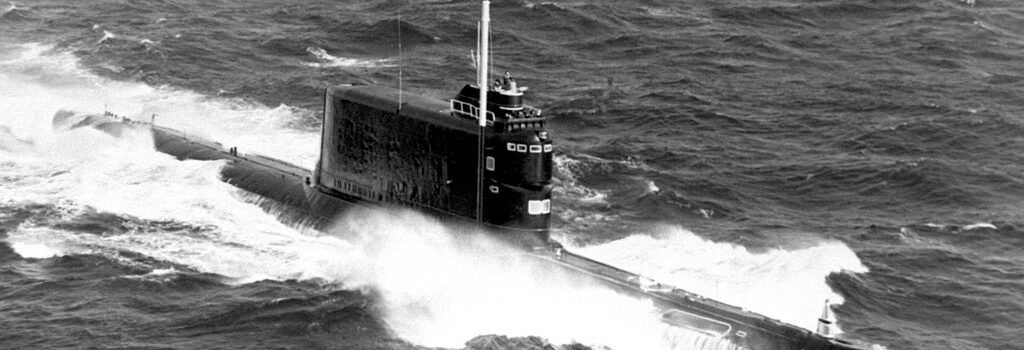
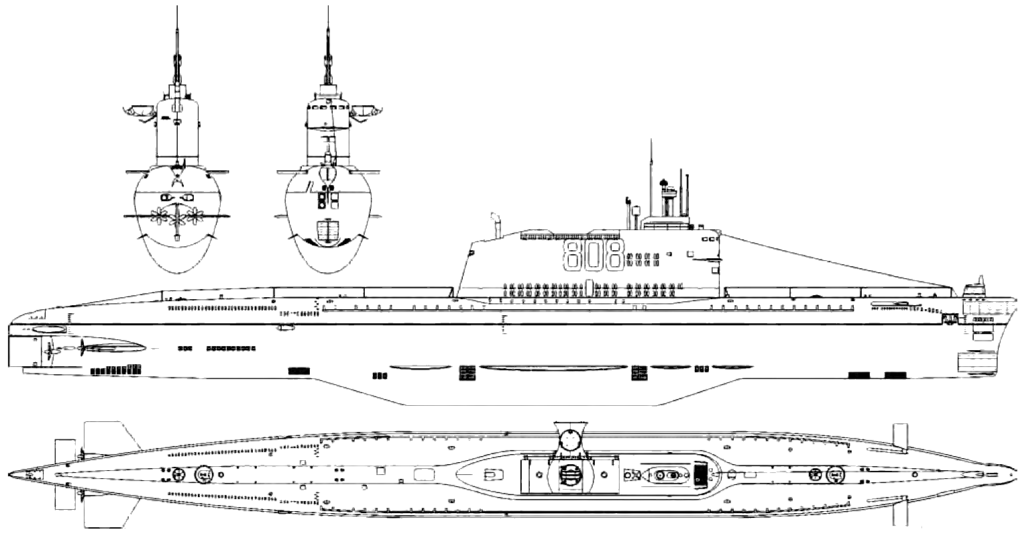

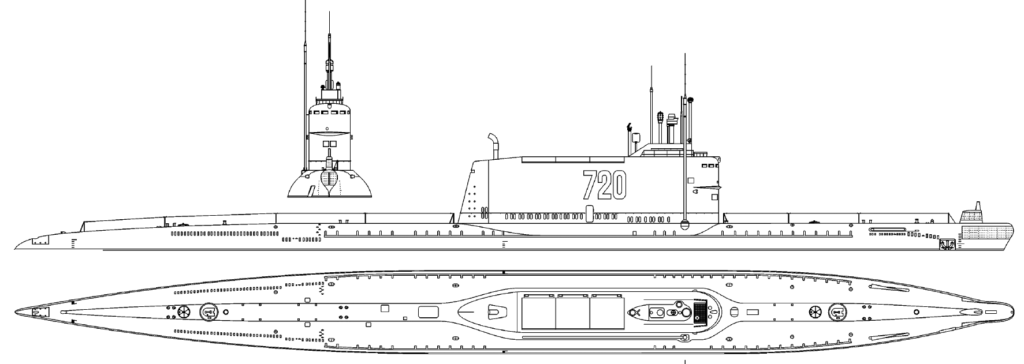
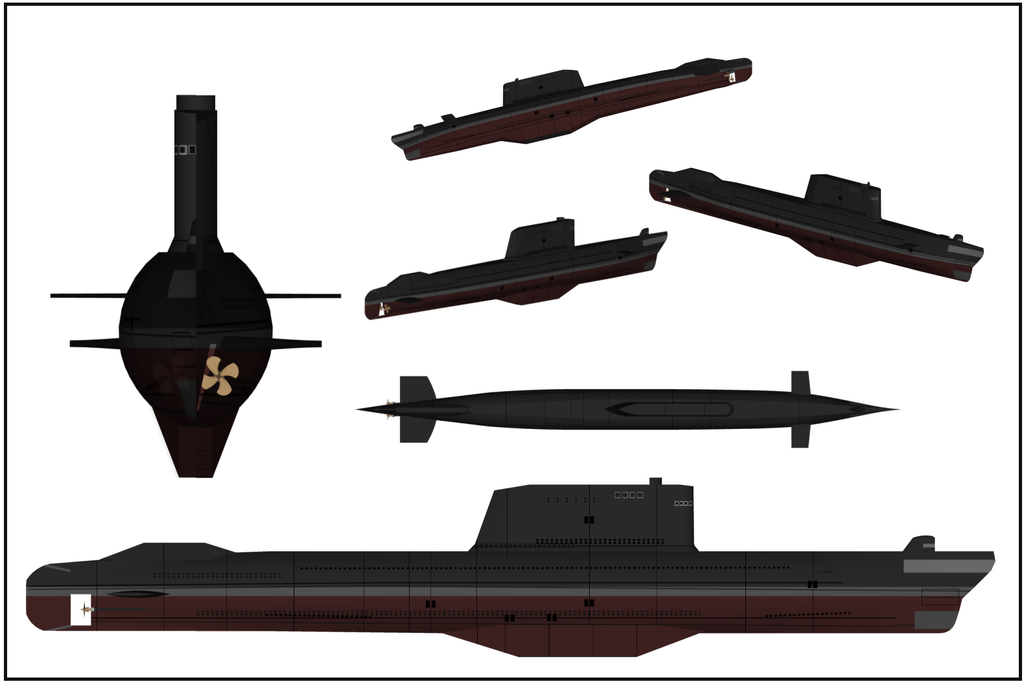
 Latest Facebook Entry -
Latest Facebook Entry -  X(Tweeter) Naval Encyclopedia's deck archive
X(Tweeter) Naval Encyclopedia's deck archive Instagram (@navalencyc)
Instagram (@navalencyc)





 French Navy
French Navy Royal Navy
Royal Navy Russian Navy
Russian Navy Armada Espanola
Armada Espanola Austrian Navy
Austrian Navy K.u.K. Kriegsmarine
K.u.K. Kriegsmarine Dansk Marine
Dansk Marine Nautiko Hellenon
Nautiko Hellenon Koninklije Marine 1870
Koninklije Marine 1870 Marinha do Brasil
Marinha do Brasil Osmanlı Donanması
Osmanlı Donanması Marina Do Peru
Marina Do Peru Marinha do Portugal
Marinha do Portugal Regia Marina 1870
Regia Marina 1870 Nihhon Kaigun 1870
Nihhon Kaigun 1870 Preußische Marine 1870
Preußische Marine 1870 Russkiy Flot 1870
Russkiy Flot 1870 Svenska marinen
Svenska marinen Søværnet
Søværnet Union Navy
Union Navy Confederate Navy
Confederate Navy Armada de Argentina
Armada de Argentina Imperial Chinese Navy
Imperial Chinese Navy Marinha do Portugal
Marinha do Portugal Mexico
Mexico Kaiserliche Marine
Kaiserliche Marine 1898 US Navy
1898 US Navy Sovietskiy Flot
Sovietskiy Flot Royal Canadian Navy
Royal Canadian Navy Royal Australian Navy
Royal Australian Navy RNZN Fleet
RNZN Fleet Chinese Navy 1937
Chinese Navy 1937 Kriegsmarine
Kriegsmarine Chilean Navy
Chilean Navy Danish Navy
Danish Navy Finnish Navy
Finnish Navy Hellenic Navy
Hellenic Navy Polish Navy
Polish Navy Romanian Navy
Romanian Navy Turkish Navy
Turkish Navy Royal Yugoslav Navy
Royal Yugoslav Navy Royal Thai Navy
Royal Thai Navy Minor Navies
Minor Navies Albania
Albania Austria
Austria Belgium
Belgium Columbia
Columbia Costa Rica
Costa Rica Cuba
Cuba Czechoslovakia
Czechoslovakia Dominican Republic
Dominican Republic Haiti
Haiti Hungary
Hungary Honduras
Honduras Estonia
Estonia Iceland
Iceland Eire
Eire Equador
Equador Iran
Iran Iraq
Iraq Latvia
Latvia Liberia
Liberia Lithuania
Lithuania Mandchukuo
Mandchukuo Morocco
Morocco Nicaragua
Nicaragua Persia
Persia San Salvador
San Salvador Sarawak
Sarawak Uruguay
Uruguay Venezuela
Venezuela Zanzibar
Zanzibar Warsaw Pact Navies
Warsaw Pact Navies Bulgaria
Bulgaria Hungary
Hungary

 Bundesmarine
Bundesmarine Dutch Navy
Dutch Navy Hellenic Navy
Hellenic Navy Marina Militare
Marina Militare Yugoslav Navy
Yugoslav Navy Chinese Navy
Chinese Navy Indian Navy
Indian Navy Indonesian Navy
Indonesian Navy JMSDF
JMSDF North Korean Navy
North Korean Navy Pakistani Navy
Pakistani Navy Philippines Navy
Philippines Navy ROKN
ROKN Rep. of Singapore Navy
Rep. of Singapore Navy Taiwanese Navy
Taiwanese Navy IDF Navy
IDF Navy Saudi Navy
Saudi Navy Royal New Zealand Navy
Royal New Zealand Navy Egyptian Navy
Egyptian Navy South African Navy
South African Navy






























 Ukrainian Navy
Ukrainian Navy dbodesign
dbodesign